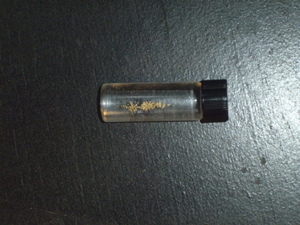When most people think of prospecting for gold, images of crisp mountain streams or old sourdoughs usually come to mind. Yet with gold prices hovering around $1800 an ounce (Feb. 2012) and new hit TV shows exposing the fact that people really are making a living off of mining for gold, a modern day gold rush just might reignite America’s love of the shiny metal.
I decided to try my hand at prospecting on an uncannily beautiful winter day. My unemployed status and love for anything outdoors fueled my desire to find a few flakes of gold to call my own. With a bit of research I found that a local historian, Lois Lindstrom, discovered that a Georgian prospector by the name Lewis Ralston made the first gold discovery in Colorado in 1850 not far from my house. This gave me the extra motivation I needed. I headed to a local prospecting shop, bought a gold pan and my journey began.
Gold Strike Park seemed like a logical place to start. The park was set aside to celebrate Ralston’s discovery near the intersection of Ralston Creek (named after Lewis Ralston) and Clear Creek. Ralston’s journal proclaimed that he found nearly a quarter ounce of gold worth about $5 in his day. The site of his discovery is now a trailer park and that quarter ounce of gold is now worth about $450.
When I arrived at the park, the snow from a previous storm had yet to melt off, but the sun was shining and my spirits were high. I headed down the cement path and across a monumental pedestrian bridge to the other side of clear creek. Cars were whizzing by on an overpass just above the sand bar, and an interstate just east introduced a decidedly modern feel to the scenery.
In the spirit of Ralston I sunk my shovel into the sand bar, filled my gold pan with material, and began my quest for riches. The water was cold, and litter lined the once pristine creek, which is of little consequence to someone who’s been struck by the gold bug. I swirled the rocks and sand in the pan, letting the lighter material work itself out, over and over for about 15 minutes until there was only heavy material left in the pan. The moment of truth had arrived. Had I found gold?
Beneath the black sands in my pan, I scoured the material looking for any signs of gold. Pyrite, or fools gold, got my hopes up more than once, but dashed them just as quickly as I realized gold is not that lite. As I swirled the pan in a circular motion, removing a thin layer of black sand with each pass, my hopes of finding gold faded with each layer.
Just as I was about to throw the remaining material back into the creek, I saw it. I saw that glorious piece of gold. There was no mistaking it. Nothing could glimmer and be so beautiful as that tiny speck of gold in the bottom of my pan. I didn’t dare touch in fear of loosing it, it didn’t matter that you nearly needed a microscope to see it, I had found gold!
The rest of the day was spent on that same sand bar, doing that same routine. Passer bye’s would stop to see what I was doing, a bum introduced himself and we had a swift conversation about the economy, a man with a golf club asked if I had seen a tall man who trespassed on his property.
Between the noise of the traffic on the overpass, the constant flow of pedestrians on the bike path, and the refuse of modern society lining the creek, it was hard to imagine what this place was like in Ralston’s time. Yet partaking in a hobby, or in previous times a way of living that helped build America, I was able to get a glimpse of a simpler time with each swirl of my pan. A time when a man could journey across this land without running into a barbed wire fence or a metropolis congested with traffic. A time when $5 was a decent amount of money. A time when you could make a living without having a job. I was beginning to see why gold panning was so appealing.
